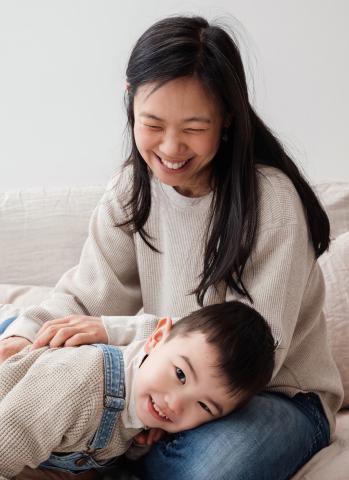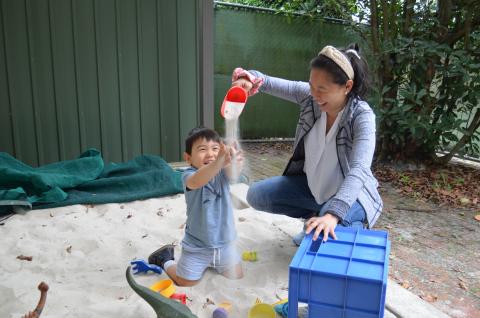
Lucia and three-year-old Maxi are part of the SWAN community – a group of families whose members have rare and sometimes undiagnosed genetic conditions.
Lucia had previously seen several medical professionals to find the cause of her son’s hypotonia and seizures. After moving to Melbourne, she says she’s lucky to have found a neurologist and geneticist who gave Maxi excellent care. She also knows many families in SWAN who haven’t had that experience.
In Lucia’s view, what differentiates good care is not the eventual diagnosis or management – it’s how genetic experts engage the family at each step.
Here is what Lucia says her son’s clinicians did right.
She was involved in the search for answers.
Lucia recalls her first meeting with Prof Andrew Kornberg, a paediatric neurologist at The Royal Children’s Hospital.
“When he inspected Maxi, he said something I will never forget. He said: My responsibility as a medical professional is to try to help you find some answers to help Maxi. After a year of no answers and no pathways provided by our previous neurologist, to have somebody say those words was like a big weight lifted off my shoulders.”
Lucia and Maxi were then referred to Prof Martin Delatycki, a geneticist working at the hospital. Prof Delatycki took saliva samples from Maxi and both his parents. Over the next few months, he ran a chromosomal microarray, a Fragile X test, and then whole exome sequencing.
While the final genomic test pinpointed Maxi’s condition, not much was known about it. “It’s ultra-rare,” says Lucia, “There’s only one research paper with six individuals with this condition.”
While acknowledging the lack of information on Maxi’s condition, Prof Delatycki invited Lucia to help find answers. “Even though we don’t have many cases to understand what Maxi’s future looked like, he said, just look at him. He will be your biggest teacher around what he needs.”
Parents are partners in the diagnostic and treatment process, Lucia says. “I talk about a good collaboration between the patient, the parents and the medical professional, and that triangulation should be present at every single stage of a diagnostic journey.”
She’s met other families who had a very different experience. “What I hear from other families is that the pathway can oftentimes be dictated by the medical professional and the parents just nod – because there is a power differential and lack of knowledge or expertise, so parents feel inadequate to voice their opinions or thoughts. And because parents and patients have no input in the process, it can sometimes increase the anxiety levels.
“From my experience, we were treated as equals and were consulted along the way around options, pathways. When Prof Delatycki proposed genetic testing, he asked what I thought and was always seeking feedback. At every decision-making point, we felt respected and our voices were taken into account. I knew there and then that we had found the right team for Maxi.”
How should you communicate a genetic diagnosis?
Watch Episode 3 of the Diagnosis Day mini-series to get some tips from families.
Each step in the journey was communicated with care.
When families are under stress, Lucia says it’s important for genetic professionals to summarise complex information, repeat key points and check for understanding.
“Every time we go to Prof Kornberg’s appointments, he repeats what he’s going to do at the end. For example, he’d say, okay, we are agreeing we will continue to investigate. I will put you in touch with another expert.
“When he put Maxi on a new medication for seizures, he would refer over and over again to when we would be using it, why we are using it, when we would review it, and what the next step might be if this medication was not controlling Maxi’s seizures. But he would always remind us not to worry about next steps yet and just focus on what we can control at the moment.”
“While it’s fine to talk about risks and different scenarios, it’s great that he always brings it back to what we can do right now. And he sends a follow-up letter with what was discussed in the appointment and a time for the next appointment, so the pathway is clear.”
They were treated as humans first and patients second.

“One of the most beautiful things about our first appointment with Prof Kornberg was that when he talked to us, he kept smiling and looking at Maxi with the most compassionate eyes. I felt like he was seeing Maxi for who he is,” Lucia recalls.
Another interaction with Dr Kornberg gave Lucia a new perspective. “I remember when discussing management and supports following Maxi’s diagnosis, he said, we could do a lot of intensive blocks of therapy to try to catch up on his developmental delay. But don’t forget, he’s a toddler. And like any child, he has to be a child, too. So pace yourself in the same way that he would do. For me, that was a good reminder to just enjoy the little moments and enjoy our child at whatever stage of development he was. To let him be a kid and let me be a parent too.”
This is why Lucia feels genetic health professionals need to talk about more than symptoms, diagnoses and treatment options. “You need to bring a sense of humanity as well. You’re talking about children, you’re talking about families, you’re talking about emotions and feelings. If we can make that standard, it would be amazing for other families.
She was encouraged to learn more and make her own connections.
For anxious parents, the internet can either be a vital source of information or a new source of worry. Lucia feels that genetic health professionals can help with perspective.
“I remember when Prof Delatycki delivered the news about Maxi’s condition, he encouraged us to look for information on Google, but also cautioned us about going down a rabbit hole.
“He also let us know there were groups that could help, one of those was SWAN. I signed up and filled out a form saying they could contact me. While I was still overseas, I got a call from SWAN saying welcome, and just checking in on me and seeing what else I might need support with.”
Lucia’s experience led her to become more actively involved in SWAN, as well as joining the family advisory council at The Royal Children’s Hospital. “This is just my way of contributing back to the community that we are part of: by providing our perspective, the voice of the consumer, so that they understand how to improve their processes and internal policies and help more families like ours.
“How can we make the whole thing better for other families? That’s what really drives me.”
Paediatricians: Check out our step-by-step guide to ordering genomic tests
Parents: Read about genomic testing for children with complex medical conditions
